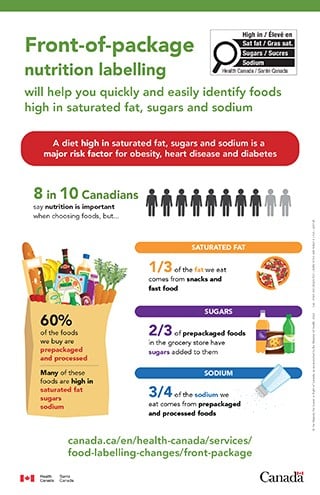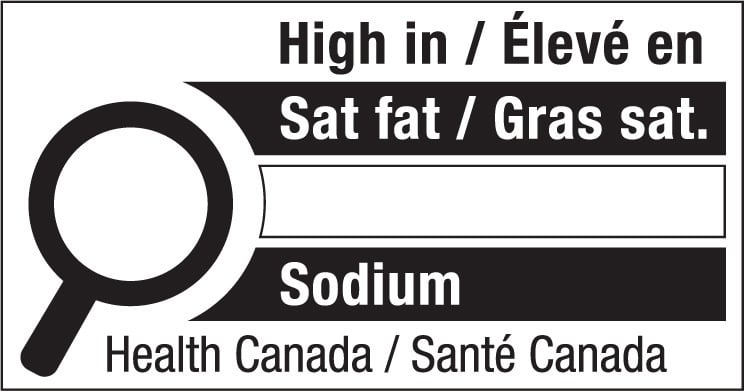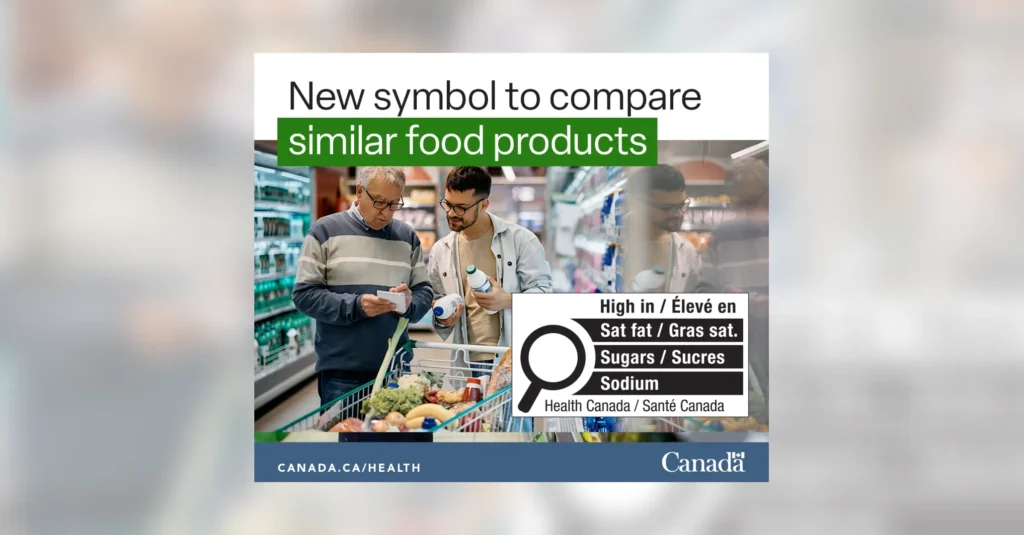Nutrition information transparency is in high demand by global consumers and has been a long-term goal of government agencies in Canada and the U.S. This new transparency is intended to address growing rates of diet-related chronic disease, such as obesity, type 2 diabetes, heart disease, certain cancers, and other ailments.
Front-of-Package (FOP) labeling also makes it easier for shoppers to quickly understand what’s in their food without getting lost in complex nutrition panels. By simplifying nutritional information, these labels can help people make better choices that fit their health goals and dietary needs.
Canada Announces New Mandatory Front-of-Package Labels
Canada’s front-of-package labeling initiative is a proactive measure to empower consumers, improve public health, and encourage healthier food production and consumption. It’s part of Canada’s broader Healthy Eating Strategy and aligns with international recommendations from organizations like the World Health Organization (WHO) and Pan American Health Organization (PAHO).
In July, they finalized new regulations that take effect in January 2026 that require FOP labeling for most packaged foods that are high in certain nutrients. These rules are aimed at encouraging healthier consumer choices as well as intended to incentivize manufacturers to reformulate products to avoid FOP warnings that could risk lost sales, making overall food offerings healthier.

Which Ingredients Will Be Included in Canadian Front-of-Package Labels?
The three nutrients that will appear in FOP labels are saturated fat, sodium, and sugars that meet or exceed certain levels. Canada selected them because their research shows that frequent consumption of foods high in these nutrients is closely linked to an increased risk of major chronic diseases.

Foods that will require the nutrition symbol include:
- Packaged foods that meet or exceed 15% of the Daily Value (DV) per serving
- Foods in small packages (≤30g reference amount) that meet or exceed 10% DV per serving
- Prepackaged main dishes (≥200g reference amount) that meet or exceed 30% DV per serving
There are some exemptions from the nutrition symbols, including:
- Whole fruits and vegetables
- Plain dairy and meats
- Certain single-ingredient foods (e.g., sugar, honey, maple syrup)
- Very small packages and technical limitations
What is the U.S. Planning?
The U.S. Food and Drug Administration (FDA) is currently considering a front-of-package labeling system. They released a proposed rule in early 2025 that would complement the existing Nutrition Facts panel. It’s also designed, like Canada’s, to help consumers identify healthier food choices more easily.
Key Details of the FDA’s Proposed Rule:
- Nutrients displayed would include saturated fat, sodium, and added sugars.
- Each nutrient would be shown with a “Low,” “Medium,” or “High” label plus % Daily Value
- There is the potential for mandatory or voluntary statement of calories.
Once this final rule is established, a compliance date of three years for large businesses and four years for small businesses will take effect.
What’s Next?
Canada’s program is now in its implementation phase, with food manufacturers either redesigning packaging or reformulating products to stay below nutrient thresholds. Educational campaigns are also being launched to help consumers understand and use the new labels.
In the U.S., the FDA’s proposed rule could still be modified or delayed, depending on the outcome of the comment period and potential legal or political challenges. If adopted as currently proposed, it would mark one of the most significant changes to U.S. nutrition labeling in decades.
A Global Movement for Improving Public Health
Countries such as Chile, Mexico, and the UK have already implemented similar FOP labeling systems. In Canada and the U.S., the goal is the same: empower consumers to make healthier food choices at a glance and hold food companies accountable for the nutritional quality of their products.
As implementation moves forward in Canada and debate continues in the U.S., one thing is clear: the way we read food labels, and the impact those labels have, is going to change the purchasing behavior of consumers as well as empower them to make the healthiest choices.










